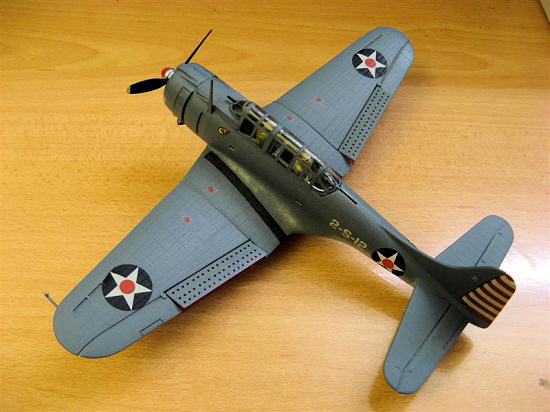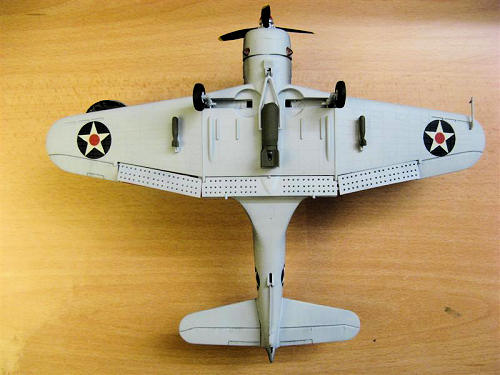
| KIT #: | 5212 |
| PRICE: | $ |
| DECALS: | One option |
| REVIEWER: | Lee Fogel |
| NOTES: | An old classic that can still shine with some extra work |

| HISTORY |
The
| THE KIT |
 Since the mid 1990ís the 1/48 scale modeling
world has had their pick between the Hasegawa and Accurate Miniatures SBD
Dauntless kits.
However, before
these two kits showed up there was the Monogram SBD kit.
Released in the early 1960ís it has working features like retracting main
gear, a bomb that drops and working dive flaps.
Having recently completed a Hasegawa SBD-3 I decided to backtrack a bit
and see if I could build a reasonable representation out of the old Monogram
kit.
Since the mid 1990ís the 1/48 scale modeling
world has had their pick between the Hasegawa and Accurate Miniatures SBD
Dauntless kits.
However, before
these two kits showed up there was the Monogram SBD kit.
Released in the early 1960ís it has working features like retracting main
gear, a bomb that drops and working dive flaps.
Having recently completed a Hasegawa SBD-3 I decided to backtrack a bit
and see if I could build a reasonable representation out of the old Monogram
kit.
Upon opening the box we find three sprues.
Molded in black and dark blue the airframe has rivet detail and finely
raised panel lines with separate dive flaps.
There is a decent amount of flash to be cleaned up especially on the
black sprue.
The engine cowling
front and engine are molded as one part.
The engine detail is pretty good though.
Also included are a pilot, rear gunner,
| CONSTRUCTION |
 the trigger portion
that sticks out of the lower fuselage.
I did install the piece that sticks down to hold the bomb in place.
At this point I drilled out the molded in exhaust pipes and then joined
the fuselage halves together.
I
used Plastruct liquid glue for this and noticed that the hard, brittle plastic
takes a bit longer to melt together.
I filled in the open area on the fuselage for the bomb release with CA
glue and attached the cowling/engine front.
Make sure to paint the dive sight at this time as you will not be able to
(very well) once the canopy is glued
into place.
the trigger portion
that sticks out of the lower fuselage.
I did install the piece that sticks down to hold the bomb in place.
At this point I drilled out the molded in exhaust pipes and then joined
the fuselage halves together.
I
used Plastruct liquid glue for this and noticed that the hard, brittle plastic
takes a bit longer to melt together.
I filled in the open area on the fuselage for the bomb release with CA
glue and attached the cowling/engine front.
Make sure to paint the dive sight at this time as you will not be able to
(very well) once the canopy is glued
into place.
Moving to the wings I made the choice to drill
out all of the holes on the dive brakes.
Itís not near as tedious as it initially appears and is well worth the
time and effort.
The inside of
these parts have sink holes and raised copyright detail that needs to be
sanded/filled for a perfect look.
After doing this I primed the insides with Dupli-Color Flat White Primer and
then used Dupli-Color Universal Red for the finish color.
I have to comment that Monogram did this right as the Hasegawa kit fails
in molding the dive flaps to the wing.
After this step I moved onto the main gear.
The kit wheels have mounting holes drilled completely through them.
To solve this I cut the wheel mounting tab in half off of the main gear
and used the small piece as filler for the wheel, sanding it smooth and flat to
shape.
Then I mounted the main gear
in the lower wing and glued the upper wing halves to lower wing section.
The gear was left to retract and was not glued into place.
I completed the two 500lb. bombs and set them aside for painting.
The following day I mated the fuselage to the wing section. These assemblies fit together pretty well with a small amount of filler needed. I attached the horizontal stabs at this time along with the pitot tube and main gear covers. The two-piece canopy was masked with Bare Metal Foil at this time and glued into place with 15 minute epoxy. The main wheels were painted MM flat black and the hubs painted MM Light grey with Tamiya silver for the outer ring of the hub. The bombs were painted MM Olive Drab and set aside to be attached at the end of the build.
| COLORS & MARKINGS |
I had decided to use my leftover Hasegawa
decals (from kit Jt 19) to finish this kit.
As the SBDs at  attached to the
airframe.
Then the kit was painted
MM Intermediate Blue over MM light Gray.
I then used MM Flat Black to paint the engine front and wing walkways.
I finished the engine off with a dry brushing of Testors Silver and Steel
and painted the center hub MM Light Gull Grey.
I sprayed Testors Glosscote onto the model and used the old Hasegawa
decals.
Some of them were brittle
and wanted to break.
I knew this
from the ones I used to finish my Hasegawa kit with.
Following Mr. Van Akenís suggestion I coated each decal with Testors
Gloss Coat.
This kept them from
splintering but I made sure to take my time and be careful.
This process also makes the decal take longer to separate from the
backing sheet.
Solvaset was used to
help the decals lay down.
The
red/white vertical stab decals fit pretty well but are slightly larger than the
Monogram vertical stab.
I applied
both and let them dry and then trimmed off the excess decal.
attached to the
airframe.
Then the kit was painted
MM Intermediate Blue over MM light Gray.
I then used MM Flat Black to paint the engine front and wing walkways.
I finished the engine off with a dry brushing of Testors Silver and Steel
and painted the center hub MM Light Gull Grey.
I sprayed Testors Glosscote onto the model and used the old Hasegawa
decals.
Some of them were brittle
and wanted to break.
I knew this
from the ones I used to finish my Hasegawa kit with.
Following Mr. Van Akenís suggestion I coated each decal with Testors
Gloss Coat.
This kept them from
splintering but I made sure to take my time and be careful.
This process also makes the decal take longer to separate from the
backing sheet.
Solvaset was used to
help the decals lay down.
The
red/white vertical stab decals fit pretty well but are slightly larger than the
Monogram vertical stab.
I applied
both and let them dry and then trimmed off the excess decal.
Weathering consisted of using Formula P3
| CONCLUSIONS |
For a quick knockout that looks the part the
old Monogram kit gets the job done.
Itís not detailed much in the cockpit area and the main wheels are small but
with a good paint job and nice decals it will look good on your shelf.
The extra effort put into the dive flaps and small details makes a big
difference.
The pilot and rear
gunner help fill the plain (and not
entirely correct) interior and the additional figures and accessories really
round out the kit.
I would
recommend replacing the kit decals though and using a set of aftermarket main
wheels.
And if you do want to go
all out Medallion Models made a very nice detail set for this kit.
If you can find one I recommend purchasing it.
The old KMC cockpit set should work here as well.
Donít blow this one off if you find it cheap and want to quickly knock
something out.
Youíll be pleasantly
surprised at how well it comes together and looks the part!
| REFERENCES |
http://www.worldwar2history.info/Coral-Sea/
http://www.aviation-history.com/douglas/sbd.html
http://www.militaryfactory.com/aircraft/detail.asp?aircraft_id=297
October 2009
Copyright ModelingMadness.com. All rights reserved. No reproduction in any form without express permission from the editor.
If you would like your product reviewed fairly and quickly, please contact the editor or see other details in the Note to Contributors.